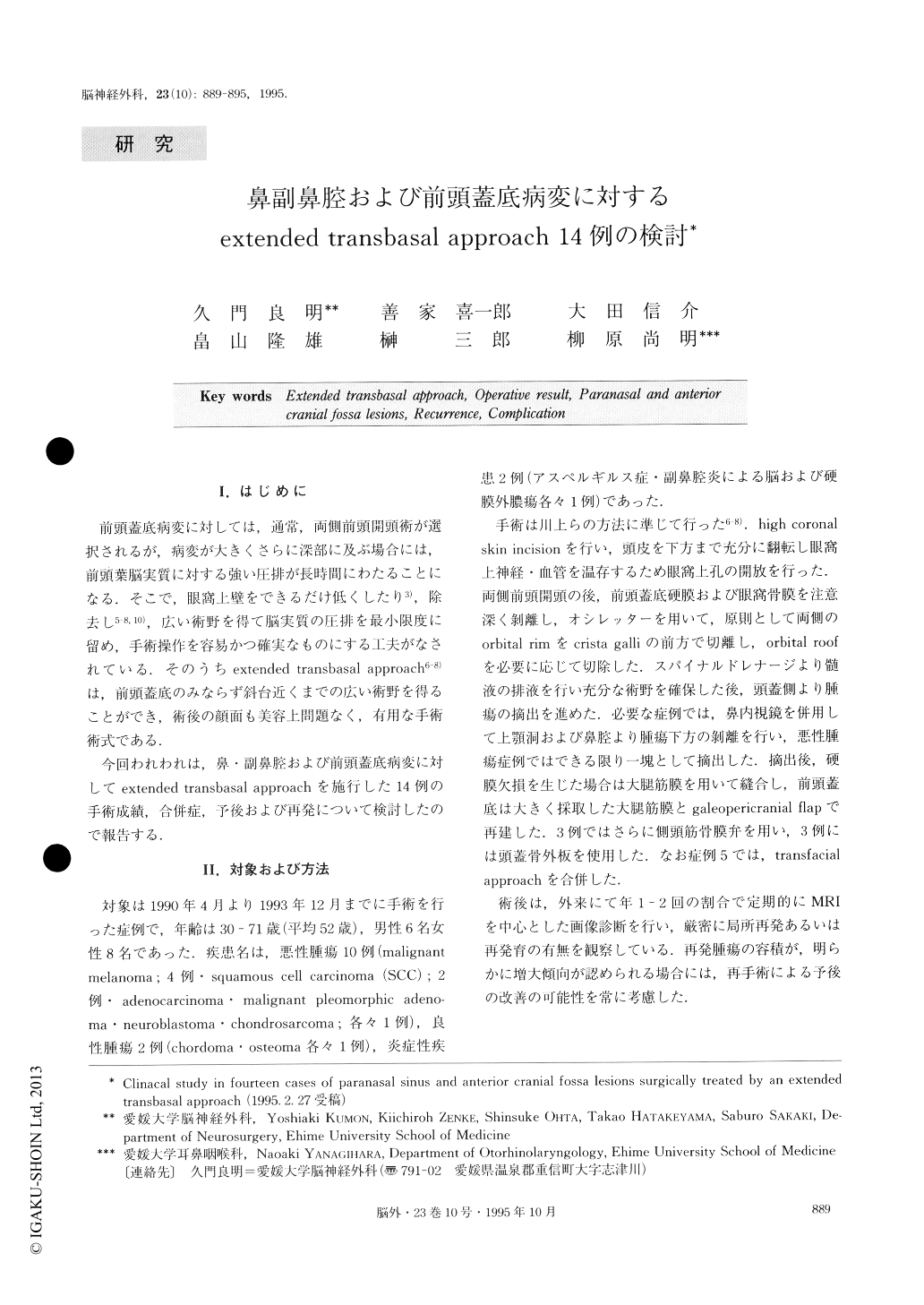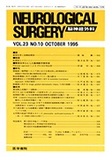Japanese
English
- 有料閲覧
- Abstract 文献概要
- 1ページ目 Look Inside
I.はじめに
前頭蓋底病変に対しては,通常,両側前頭開頭術が選択されるが,病変が大きくさらに深部に及ぶ場合には,前頭葉脳実質に対する強い圧排が長時間にわたることになる.そこで,眼窩上壁をできるだけ低くしたり3),除去し5-8,10),広い術野を得て脳実質の圧排を最小限度に留め,手術操作を容易かつ確実なものにする工夫がなされている.そのうちextended transbasal approach6-8)は,前頭蓋底のみならず斜台近くまでの広い術野を得ることができ,術後の顔面も美容上問題なく,有用な手術術式である.
今回われわれは,鼻・副鼻腔および前頭蓋底病変に対してextended transbasal approachを施行した14例の手術成績,合併症,予後および再発について検討したので報告する.
We describe the outcomes and complications of 14 patients with paranasal sinus and anterior cranial fossa lesions surgically treated by an extended transbasal approach, originally described by Kawakami, in our de-partment. They were 10 patients with malignant tumors, 2 with benign tumors, and 2 with inflammatory diseases.
A bifrontal craniotomy was performed using a high coronal skin incision, and the orbital rim and roof were removed after the dissection of the dura mater from the anterior skull base. Transcranial resection of the tumor was performed, and assisted by transnasal and trans-maxillar resection using a nasal endoscope. Reconstruc-tion of the anterior skull base was performed with the fascia lata and galeopericranial flap in all cases, tempor-al musculo-pericranial flap in 3 and free bone flap from the cranial convex in 3.
Among 10 patients with malignant tumors (malig-nant melanoma; 4, squamous cell carcinoma; 2, adeno-carcinoma; 1, malignant pleomorphic adenoma; 1, chondrosarcoma; 1, and neuroblastoma; 1), total re-moval was performed in 5 patients and subtotal remov-al in 5 patients. Though local recurrence of the tumor was recognized in 6 patients, only one underwent addi-tional surgery. Eight patients survived, and 2 patients died of systemic metastasis of the tumor and complica-tions due to liquorrhea. Seven patients obtained a good quality of life, and the mean survival period in 8 pa-tients still living was 27 months after the first surgery. In 2 patients with benign tumors (chordoma and osteoma), partial and total removal was performed. The patient with chordoma was operated on several times by this approach and the transoral approach, re-spectively. Each had a good postoperative course. In 2 patients with inflammatory diseases (brain abs-cess with frontal sinusitis and aspergillosis), total re-moval was performed. The patient with the brain abs-cess returned to his former position, but the other de-veloped an epidural abscess and needed reoperation. Postoperative complications were liquorrhea in a pa-tient with squamous cell carcinoma who received irra-diation and chemotherapy before combined transbasal and transfacial approach, and an epidural abscess in a patient with aspergillosis complicated by diabetes melli-tus. In both patients, the skull base was reconstructed with fascia lata and a galeopericranial flap. The wound healing process in both of these patients was poor. The surgical goal for malignant tumors in the ante-rior skull base seemed to be to prolong the patient's sur-vival time with good quality of life, and the surgical re-sults for benign lesions in this region were satisfactory. ReConstruction of the anterior skull base using fascia lata and a galeopericranial flap obtained good results, except in cases where the healing process was poor.

Copyright © 1995, Igaku-Shoin Ltd. All rights reserved.


